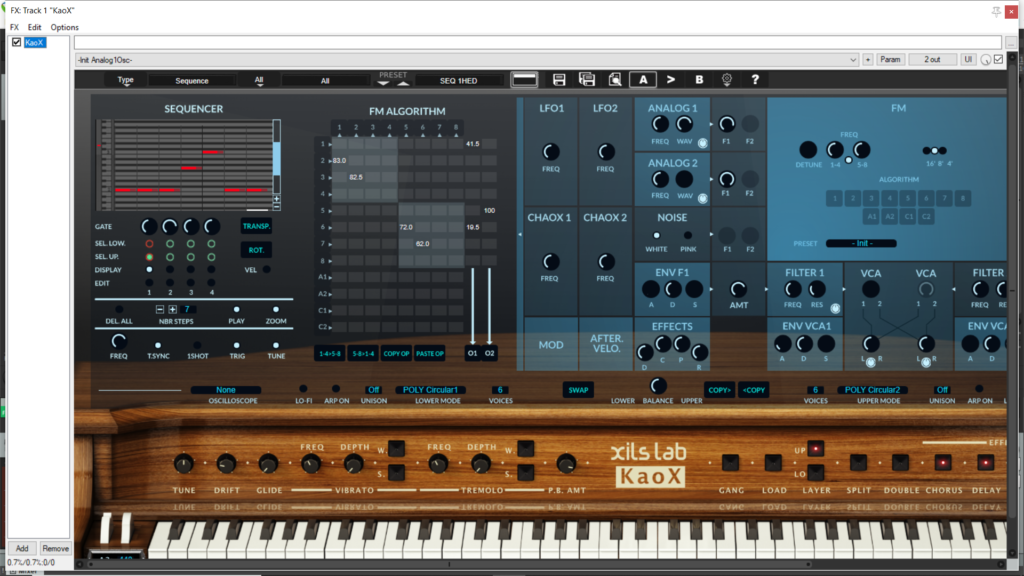The sonic masters at XILS-Lab recently crafted another unique software synth, this time combining FM and analog synthesis. Somewhat modeled after the Yamaha GS-1, the predecessor to the DX7, KaoX also leverages virtual analog and chaotic oscillators to greatly expand its sonic depth. Its range of sounds is stunning, taking FM synthesis to an entirely new level.
XILS-Lab KaoX Features
- One FM Oscillator With Eight Operators
- Two Virtual Analog Oscillators With Variable Waveforms
- Two Chaotic Oscillators With a Variety of Algorithms
- Two Virtual Analog Filters
- Two LFOs
- Two ChaoX Modulators
- Four DADRS Envelopes
- Two Separate Configurable Synthesizer Engine Layers
- Modulation Matrix
- Dual Arpeggiators
- Four Track Sequencer
- Four Effects With Independent Routings
- Supports VST, AU, and AAX Plugin Formats for Windows and MacOS
- Available for $159 from XILS-Lab
If you read our reviews of other XILS-Lab synths, like PolyM and XILS 505, you know they remain one of our favorite synth plugin makers. If anything, KaoX increases their reputation in our mind. It’s a stunning piece of work, capable of sounds far beyond either FM or virtual analog synthesis. Let’s dive into this sonic maelstrom!
A Massive Sounding Synth Deserves a Massive User Interface
With its large sound and detailed functionality, it’s not surprising that KaoX sports a rather huge user interface. However, the plugin shares common interface elements with other XILS-Lab synths. For example, the toolbar residing at the top provides access to patch library functionality as well as settings.

However, the meat of the KaoX interface lies beneath the toolbar. It’s a massively wide window unable to completely fit within my 15-inch laptop screen, so scrolling is necessary. Thankfully, KaoX features different collapsible windows to streamline things, but expect to scroll at times. Still, the interface remains highly accessible and easy to navigate. XILS-Lab also included a simple mode which hides most of the interface. This skeuomorphic wood-paneled view lets you stack or split layers (more on that below), turn effects on/off, add tremolo or vibrato, and more.
Beyond that, covering the rest of the KaoX interface makes more sense as part of exploring its robust synthesizer architecture. As noted earlier, it’s a mashup of FM and virtual analog synths, creating a sonic behemoth capable of significant mayhem and chaos. Here’s a closer look.
The Yamaha GS-1 and Sequential Prophet 5 Give Birth to a Mutant Synth
The KaoX synth architecture provides sound designers with multiple oscillators, as well as a standard array of filters, VCAs, and more. Three types of oscillators exist: virtual analog, chaotic, and FM. Routing options abound, with all oscillators able to be routed to the filters and the VCAs separately.
Importantly, KaoX features two independent synthesizer layers, so the entire synth architecture essentially repeats itself. The synth’s effects engine (phaser, chorus, reverb, and delay) allows each effect to be routed to either or both of the synth layers. Needless to say, the sonic possibilities are immense! Explore the robust library of presets in simple mode to hear for yourself.
Within various Advanced Settings Panels reside most of the KaoX’s interface, as described earlier. You use them for access to each synth module’s full collection of parameters, spanning an array of oscillators, filters, and more. Remember to turn off any unused modules to save CPU power.
KaoX Isn’t Your Grandmother’s DX7
The FM Algorithm matrix and FM operator module both contain various controls to manage the synth’s single FM oscillator. Note that KaoX provides little introduction to the concepts of FM synthesis. Use another source to learn more about this rather esoteric synthesis type. However, the accessible KaoX interface rewards exploration and empirical analysis, making it easier to craft your own FM or hybrid patches.
Ultimately, KaoX offers possibilities that greatly exceed those overused 80s DX7 sounds. Being able to modulate any FM operator with the virtual analog and chaotic oscillators provides an unlimited realm of sonic mayhem. You also have control over a variety of settings for each FM operator, including its ratio, offset, and detuning. There’s also a separate filter and envelope for each, providing controls for cutoff frequency, and ADSR.
You are also able to modulate operators using velocity, the modulation wheel, and the internal modulation matrix. The FM oscillator also provides two separate outputs, with either routable to either filter or VCA. Needless to say, this robust architecture combined with the other oscillator options sets KaoX apart from similar DX7 clones in the soft synth realm.
Chaotic and Analog Oscillators Add to The Mayhem
As noted earlier, KaoX features two pairs of virtual analog and chaotic oscillators that add to the synth’s sonic maelstrom. The analog oscillators feature a continually variable waveform that changes between triangle, saw, square, and pulse. Modulate an oscillator’s Wave knob to vary its waveform. The Synchro switch hard syncs oscillator 2 to 1. Each oscillator also provides either white or pink noise for additional grunge.
KaoX’s two chaotic oscillators are “based on algorithms which mimic the chaotic behavior of the real world.” The musical purposes for this approach seem valid, especially when used to modulate the operators of the FM oscillators. Three chaos algorithms currently exist, with more to be added in the future. As with the virtual analog oscillators, the chaos oscillators are routed to either filter or directly to the VCAs.
Exploring The Rest of KaoX
KaoX features two independent filters (each with its own envelope) with five different modes, including high-pass, low-pass, and band-pass options. Basic control over the resonance and cutoff frequency exists on the filter module; clicking on it displays its Advanced Settings Panel with additional parameters for filter mode, drive, envelope modulation, and more. The drive adds a measure of saturation. You also control how much signal gets routed to VCA1, VCA2, or both.
The synth boasts four independent envelopes; two modulate the filters, and two modulate the VCAs. Again, the module has basic DADSR functionality, and clicking on it displays the Advanced Setting Panel which provides control over all four envelopes at once, including a tempo sync switch for each. Of course, all four envelopes serve as sources in KaoX’s modulation matrix.
Two LFOs also add to the modulation fun. The basic module features a frequency knob, while the Advanced Settings Panel provides a host of other controls, including tempo sync, waveform, width (for pulse and triangle waveforms), and destination for convenience compared to using the modulation matrix.
Don’t forget the two ChaoX modulators which behave like an LFO from a modulation standpoint, but in a chaotic fashion as opposed to a repetitive oscillation. Like the LFOs, there is a basic module with frequency and an Advanced Settings Panel. Various algorithms provide different forms of chaos, with varying levels of randomization.
Put these modulators to use in the 8×8 modulation matrix, allowing you to connect sources and destinations to add depth and motion to your patches. A separate panel is used for setting the destinations for the velocity and aftertouch sources. Other sources include a standard array of envelopes, modulators, oscillators, and even KaoX’s 4-step sequencer. Cool options abound!
Don’t forget about the dual arpeggiators! KaoX provides one for each synth layer. Expect typical arpeggiator parameters, along with swing and a cool chord feature. The previously mentioned basic 4-track sequencer also adds to the fun. Of course, it supports odd time signatures!
Finally, KaoX provides four separate effects: delay, chorus, reverb, and a phaser. All features a basic set of parameters, and greatly add to the sonic mayhem of the synth.
Add This Mutant Synth to Your Collection
Exploring KaoX’s massive number of presets as well as tweaking my own patches reveals a synth of great sonic depth. Those boring 80s sounds typical of FM synthesizers need not pollute your own works. Simply add some chaos with an oscillator or modulator, giving a measure of experimentation to your sound designs.
XILS-Lab built another essential synthesizer app that stands right next to PolyM and XILS-4 in our hearts. Sound designers and musicians taking an experimental approach to their work need to consider adding it to their plugin collection. It’s a behemoth, but its rich feature set rewards deep exploration of its underlying sonic possibilities. We give KaoX our highest recommendation!
